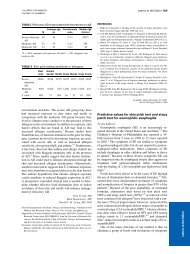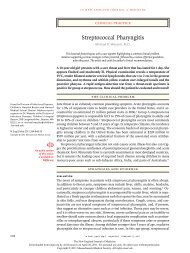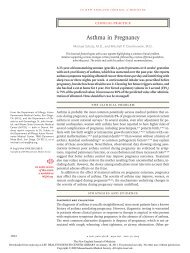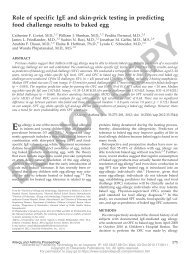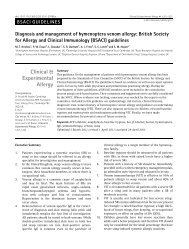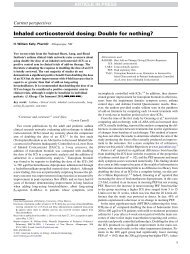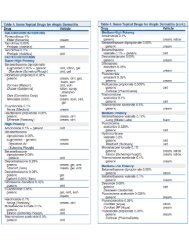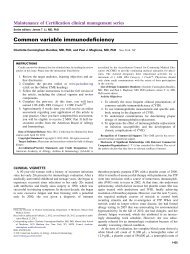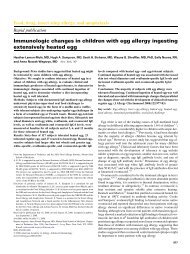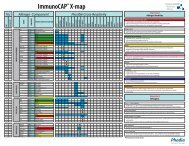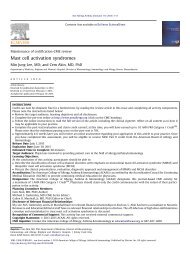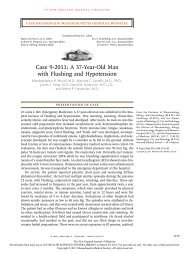Refining the definition of HES - JACI 2010.pdf - AInotes
Refining the definition of HES - JACI 2010.pdf - AInotes
Refining the definition of HES - JACI 2010.pdf - AInotes
Create successful ePaper yourself
Turn your PDF publications into a flip-book with our unique Google optimized e-Paper software.
Rostrum<strong>Refining</strong> <strong>the</strong> <strong>definition</strong> <strong>of</strong> hypereosinophilic syndromeHans-Uwe Simon, MD, PhD, a Marc E. Ro<strong>the</strong>nberg, MD, PhD, b Bruce S. Bochner, MD, c Peter F. Weller, MD, dAndrew J. Wardlaw, MD, PhD, e Michael E. Wechsler, MD, f Lanny J. Rosenwasser, MD, g Florence Roufosse, MD, PhD, hGerald J. Gleich, MD, i and Amy D. Klion, MD j Bern, Switzerland, Cincinnati, Ohio, Baltimore and Be<strong>the</strong>sda, Md, Boston, Mass,Leicester, United Kingdom, Kansas City, Mo, Brussels and Gosselies, Belgium, and Salt Lake City, UtahBecause <strong>of</strong> advances in our understanding <strong>of</strong> <strong>the</strong>hypereosinophilic syndrome (<strong>HES</strong>) and <strong>the</strong> availability <strong>of</strong> novel<strong>the</strong>rapeutic agents, <strong>the</strong> original criteria defining <strong>the</strong>se disordersare becoming increasingly problematic. Here, we discussshortcomings with <strong>the</strong> current <strong>definition</strong> <strong>of</strong> <strong>HES</strong> and recentdevelopments in <strong>the</strong> classification <strong>of</strong> <strong>the</strong>se disorders. Despitesignificant progress in our understanding <strong>of</strong> <strong>the</strong> pathogenesis <strong>of</strong>some forms <strong>of</strong> <strong>HES</strong>, <strong>the</strong> current state <strong>of</strong> knowledge is stillinsufficient to formulate a new comprehensive etiologicFrom a <strong>the</strong> Institute <strong>of</strong> Pharmacology, University <strong>of</strong> Bern; b <strong>the</strong> Division <strong>of</strong> Allergy andImmunology, Department <strong>of</strong> Pediatrics, Cincinnati Children’s Hospital Medical Center,University <strong>of</strong> Cincinnati; c <strong>the</strong> Department <strong>of</strong> Medicine, Division <strong>of</strong> Allergy andClinical Immunology, Johns Hopkins University School <strong>of</strong> Medicine, Baltimore;d <strong>the</strong> Divisions <strong>of</strong> Allergy and Inflammation and Infectious Diseases, Beth Israel DeaconessMedical Center, Harvard Medical School, Boston; e <strong>the</strong> Institute for LungHealth, Infection, Immunity and Inflammation, University <strong>of</strong> Leicester; f <strong>the</strong> Department<strong>of</strong> Medicine, Brigham and Women’s Hospital and Harvard Medical School,Boston; g <strong>the</strong> Division <strong>of</strong> Allergy Immunology, Children’s Mercy Hospital, UMKCSchool <strong>of</strong> Medicine, Kansas City; h Hôpital Erasme, Service de Médecine Interne, UniversitéLibre de Bruxelles, Brussels, and Institute for Medical Immunology, UniversitéLibre de Bruxelles, Gosselies; i <strong>the</strong> Department <strong>of</strong> Dermatology, University <strong>of</strong> Utah;and j <strong>the</strong> Laboratory <strong>of</strong> Parasitic Diseases, National Institute <strong>of</strong> Allergy and InfectiousDiseases, National Institutes <strong>of</strong> Health, Be<strong>the</strong>sda.Disclosure <strong>of</strong> potential conflict <strong>of</strong> interest: H.-U. Simon has received research supportfrom GlaxoSmithKline, AstraZeneca, Roche, CSL Behring, and Nycomed, and hasprovided legal consultation or expert witness testimony for Pfizer on <strong>the</strong> topic <strong>of</strong>general pharmacology. M. E. Ro<strong>the</strong>nberg has consulted for and given talks for Merck;has consulted for Centocor, Ception Therapeutics, Nycomed, Array BioPharma,Biocrystal Pharmaceuticals, and Endo Pharmaceuticals; has received research supportfrom <strong>the</strong> National Institutes <strong>of</strong> Health, <strong>the</strong> Food Allergy and Anaphylaxis Network, and<strong>the</strong> Dana Foundation; is on <strong>the</strong> medical advisory board <strong>of</strong> <strong>the</strong> American Partnership forEosinophilic Diseases; and is on <strong>the</strong> executive council <strong>of</strong> <strong>the</strong> International EosinophilSociety. B. S. Bochner has consulted for San<strong>of</strong>i-Aventis and GlaxoSmithKline and hasreceived research support from San<strong>of</strong>i-Aventis. P. F. Weller has received researchsupport from Merck and has provided legal consultation services or expert witnesstestimony on <strong>the</strong> topic <strong>of</strong> eosinophilic diseases. A. J. Wardlaw is on advisory boards forGlaxoSmithKline and has received research support from GlaxoSmithKline, Pfizer,and AstraZeneca. M. E. Wechsler has consulted for and given talks for Genentech,Merck, and Novartis; has consulted for MedImmune, Medicinova, and GlaxoSmith-Kline; is on <strong>the</strong> data safety monitoring board for MAP Pharmaceuticals; and hasreceived research support from <strong>the</strong> National Institutes <strong>of</strong> Health and GlaxoSmithKline.L. J. Rosenwasser has received research support from Novartis and Genentech and hasconsulted for Alcon, San<strong>of</strong>i-Aventis, GlaxoSmithKline, and AstraZeneca. F. Roufossehas consulted for GlaxoSmithKline. G. J. Gleich has provided legal consultation orexpert witness testimony on <strong>the</strong> topic <strong>of</strong> heparin contamination and is on <strong>the</strong> board <strong>of</strong>directors for <strong>the</strong> American Partnership for Eosinophilic Disorders. A. D. Klion declaresthat she has no relevant conflicts <strong>of</strong> interest to disclose.Received for publication January 4, 2010; revised March 20, 2010; accepted for publicationMarch 25, 2010.Available online May 31, 2010.Reprint requests: Hans-Uwe Simon, MD, PhD, Institute <strong>of</strong> Pharmacology, University <strong>of</strong>Bern, Friedbuehlstrasse 49, CH-3010 Bern, Switzerland. E-mail: hus@pki.unibe.ch.0091-6749/$00.00Published by Elsevier Inc, on behalf <strong>of</strong> <strong>the</strong> American Academy <strong>of</strong> Allergy, Asthma &Immunologydoi:10.1016/j.jaci.2010.03.042<strong>definition</strong> <strong>of</strong> <strong>HES</strong>s. Never<strong>the</strong>less, we suggest a new working<strong>definition</strong> that overcomes some <strong>of</strong> <strong>the</strong> most obvious limitationswith <strong>the</strong> original <strong>definition</strong>. (J Allergy Clin Immunol2010;126:45-9.)Key words: Definition, eosinophilia, eosinophilic leukemia, hypereosinophilicsyndromesThe hypereosinophilic syndrome (<strong>HES</strong>) is characterized by <strong>the</strong>presence <strong>of</strong> marked unexplained blood and tissue eosinophiliaassociated with a variety <strong>of</strong> clinical manifestations. Since 1975, 3criteria have been used to define <strong>HES</strong>: (1) blood eosinophilia>_ 1500/mm 3 for longer than 6 months (or death before 6 monthsassociated with signs and symptoms <strong>of</strong> hypereosinophilic disease),(2) lack <strong>of</strong> evidence for parasitic, allergic, or o<strong>the</strong>r knowncauses <strong>of</strong> eosinophilia, and (3) presumptive signs <strong>of</strong> organ involvement,such as heart failure, gastrointestinal dysfunction,central nervous system abnormalities, fever, or weight loss. 1LIMITATIONS OF THE CURRENT DEFINITION OF<strong>HES</strong>As new and varied diagnostic and treatment modalities havebecome available, appropriate clinical management <strong>of</strong> eosinophilicdisorders has become increasingly dependent on <strong>the</strong>accurate identification and classification <strong>of</strong> patients. In thiscontext, <strong>the</strong> criteria established by Chusid et al 1 in 1975 are becomingincreasingly problematic. For instance, it is unlikelythat a patient with symptomatic <strong>HES</strong> would remain untreatedfor 6 months given <strong>the</strong> availability <strong>of</strong> effective <strong>the</strong>rapies thatcan reduce eosinophilia before irreversible damage occurs. Similarly,<strong>the</strong> accepted threshold for blood eosinophilia excludes patientswith increased numbers <strong>of</strong> activated eosinophils in tissuesunaccompanied by marked blood eosinophilia, although <strong>the</strong> pathophysiologyin such patients is likely similar to those with peripheraleosinophilia >_ 1500/mm 3 . For example, patients with a widevariety <strong>of</strong> disorders, including eosinophilic pneumonia, eosinophil-associatedgastrointestinal disorders (EGID), Churg-Strauss syndrome (CSS), nasal polyposis with bronchial asthma,and eosinophilic dermatitis (Wells syndrome), may fulfill all <strong>HES</strong>criteria except for blood eosinophil levels, yet are not classified as<strong>HES</strong>. Conversely, some patients with blood eosinophilia >_ 1500/mm 3 do not exhibit signs <strong>of</strong> eosinophil-mediated organ damageand/or dysfunction at <strong>the</strong> time <strong>of</strong> presentation or present withsigns and symptoms, such as asthma or allergic rhinitis, for which<strong>the</strong> relationship to <strong>the</strong> eosinophilia is unclear. Although such patientswould not meet <strong>the</strong> criteria <strong>of</strong> Chusid et al, 1 <strong>the</strong>y warrantspecial attention with regard to <strong>the</strong> potential development <strong>of</strong> diseasecomplications. Finally, pathogenic studies <strong>of</strong> patient45
46 SIMON ET ALJ ALLERGY CLIN IMMUNOLJULY 2010Abbreviations usedCEL: Chronic eosinophilic leukemiaCSS: Churg-Strauss syndromeFIP1L1: Fip1-like-1<strong>HES</strong>: Hypereosinophilic syndromePDGFRA: Platelet-derived growth factor receptor aWHO: World Health Organizationsubgroups fulfilling <strong>the</strong> diagnostic criteria <strong>of</strong> Chusid et al 1 haveled to <strong>the</strong> identification <strong>of</strong> several well characterized disease entities,such as Fip1-like-1 (FIP1L1)/platelet-derived growth factorreceptor a (PDGFRA)–associated <strong>HES</strong> 2 that no longer fit into <strong>the</strong>original <strong>definition</strong> <strong>of</strong> <strong>HES</strong> as a disease <strong>of</strong> unknown pathophysiology.In conclusion, adjustments to <strong>the</strong> original <strong>definition</strong> appear tobe required to ensure optimal patient treatment.CLINICAL CLASSIFICATION OF <strong>HES</strong>sThe Hypereosinophilic Diseases Working Group <strong>of</strong> <strong>the</strong> InternationalEosinophil Society proposed a classification algorithmthat addressed some <strong>of</strong> <strong>the</strong> issues raised. 3 The term ‘‘hypereosinophilicsyndromes (<strong>HES</strong>s)’’ was introduced without <strong>the</strong> use <strong>of</strong> ‘‘idiopathic’’in order to capture <strong>the</strong> broad range <strong>of</strong> disorders includedin <strong>the</strong> original <strong>definition</strong> with 1 classification scheme. 3 Moreover,organ-restricted hypereosinophilic disorders when accompaniedby blood eosinophilia >_ 1500/mm 3 as well as CSS and isolatedblood eosinophilia >_ 1500/mm 3 were included in <strong>the</strong> new classificationscheme <strong>of</strong> <strong>HES</strong>s. 3 Accordingly, it was concluded that allpatients with blood eosinophilia >_ 1500/mm 3 without a discernablesecondary cause (eg, allergic diseases, drug hypersensitivity,parasitic helminth infections, HIV infection, nonhematologic malignancies)should be considered to have <strong>HES</strong> or a disorder thatoverlaps in <strong>definition</strong> with <strong>HES</strong>, regardless <strong>of</strong> <strong>the</strong> number and nature<strong>of</strong> affected organs or potential pathogenic mechanisms.Although <strong>the</strong> new classification addressed some <strong>of</strong> <strong>the</strong> shortcomings<strong>of</strong> <strong>the</strong> criteria used in <strong>the</strong> original <strong>definition</strong> <strong>of</strong> <strong>HES</strong>, anumber <strong>of</strong> issues remain. For instance, <strong>the</strong> current state <strong>of</strong>knowledge makes it difficult to classify patients on <strong>the</strong> basis <strong>of</strong>etiology. Consequently, <strong>the</strong> classification scheme proposed in 2006was based predominantly on clinical phenotype and included <strong>the</strong>following categories: myeloproliferative, lymphocytic, familial,idiopathic, overlap (blood eosinophilia >_ 1500/mm 3 in <strong>the</strong> setting<strong>of</strong> single organ involvement), and associated (blood eosinophilia>_ 1500/mm 3 in association with a distinct second diagnosis, suchas inflammatory bowel disease or autoimmune lymphoproliferativedisorder, in which eosinophilia has been reported with increasedfrequency but rarely leads to end organ manifestations). 3Although this scheme has been helpful in guiding managementand predicting prognosis for some patients, <strong>the</strong> majority <strong>of</strong> casesfall under <strong>the</strong> ‘‘idiopathic’’ heading, meaning that pathogenesisand disease course remain unknown and are likely heterogeneous.In addition, future investigations may reveal novel disease mechanismsthat could be difficult to incorporate into <strong>the</strong> current scheme.WORLD HEALTH ORGANIZATION CLASSIFICATIONOF <strong>HES</strong>sIn <strong>the</strong> revised World Health Organization (WHO) classification,patients presenting with signs and symptoms <strong>of</strong> <strong>HES</strong> can beclassified in 1 <strong>of</strong> 4 ways: (1) myeloproliferative neoplasm/<strong>HES</strong>,(2) myeloproliferative syndrome/chronic eosinophilic leukemia,not o<strong>the</strong>rwise categorized, (3) myeloid neoplasm associated wi<strong>the</strong>osinophilia and abnormalities <strong>of</strong> PDGFRA, platelet-derivedgrowth factor receptor-beta (PDGFRB), or fibroblast growth factorreceptor 1 (FGFR1), or (4) T-cell neoplasm/lymphoma, unclassifiable.4 Although this classification system has someutility when a clonal or neoplastic process is clearly defined,<strong>the</strong> majority <strong>of</strong> patients with <strong>HES</strong> have idiopathic disease thatprecludes definitive placement into 1 <strong>of</strong> <strong>the</strong> WHO categories.The artificial separation <strong>of</strong> patients with molecularly defined myeloproliferativedisease from those with similar clinical featuresbut no identifiable mutation is also problematic. 5PATHOGENESIS-DRIVEN CLASSIFICATION OF<strong>HES</strong>sThe division <strong>of</strong> <strong>HES</strong> into 2 subgroups, a ‘‘leukemic’’ form and asecond form in which <strong>the</strong> underlying mechanism was related to‘‘a hypersensitivity reaction <strong>of</strong> some type,’’ was first proposed in<strong>the</strong> landmark article by Chusid et al 1 in 1975. Dramatic differencesin clinical manifestations, prognosis, and response to treatmentbetween <strong>the</strong> 2 groups were noted. Since that time, <strong>the</strong>identification <strong>of</strong> specific <strong>HES</strong> entities with defined etiologieshas confirmed <strong>the</strong> existence <strong>of</strong> 2 ‘‘pathogenic’’ forms <strong>of</strong> <strong>HES</strong>, myeloproliferativeand lymphocytic, 6 each <strong>of</strong> which includes severalclinically defined distinct <strong>HES</strong> disorders (Fig 1). Here we discuss<strong>the</strong> classification <strong>of</strong> <strong>HES</strong> using a pathogenesis-driven scheme, aswell as <strong>the</strong> limitations <strong>of</strong> this approach.In <strong>the</strong> lymphocytic forms <strong>of</strong> <strong>HES</strong>, lymphocytes generateincreased amounts <strong>of</strong> at least 1 eosinophil hematopoietin (IL-3and/or IL-5) and are <strong>the</strong>refore believed to be <strong>the</strong> primary cause <strong>of</strong><strong>the</strong> secondary polyclonal blood hypereosinophilia. 7 Clear-cut involvement<strong>of</strong> dysregulated T cells in <strong>HES</strong> has been proven instudies showing marked IL-5 overexpression by immunophenotypicallyabnormal T cells, on a single-cell basis. The surface immunophenotype<strong>of</strong> <strong>the</strong>se IL-5 (and/or IL-3)–secreting T cells isvariable, suggesting different underlying mechanisms <strong>of</strong> T-celldysregulation, and clonality can be demonstrated in many, butnot all, patients by T-cell receptor rearrangement studies. 8 However,<strong>the</strong> majority <strong>of</strong> patients with steroid responsiveness do notdemonstrate a T-cell clone with an aberrant immunophenotype,but <strong>the</strong> eosinophilia is likely driven by T cell–derived cytokines,particularly when increased expression <strong>of</strong> eosinophil hematopoietinsby T cells can be demonstrated or markers <strong>of</strong> T-cell activation,such as elevated serum thymus and activation-regulatedchemokine (TARC), are present. The pathogenic events responsiblefor <strong>the</strong> generation <strong>of</strong> IL-5–producing lymphocytes in <strong>the</strong> lymphocyticforms <strong>of</strong> <strong>HES</strong>, both in <strong>the</strong> presence and absence <strong>of</strong> aT-cell clone, remain obscure.Many patients classified as having undefined, overlapping, orassociated <strong>HES</strong> forms likely have a lymphocytic form (Fig 1).This is exemplified by <strong>the</strong> case <strong>of</strong> episodic angioedema and eosinophilia,currently classified under undefined <strong>HES</strong> (Fig 1), inwhich cyclic elevations in IL-5 levels precede <strong>the</strong> episodic eosinophiliaand clinical symptoms and appearance <strong>of</strong> a detectableIL-5–secreting clone has been described in a number <strong>of</strong> cases. 9Similarly, lymphocytic overexpression <strong>of</strong> IL-5 has been demonstratedin a number <strong>of</strong> organ-restricted eosinophilic disorders,including eosinophilic pneumonia, eosinophilic intrinsic asthma,CSS, eosinophilic sinus disease, eosinophilic dermatitis, and
J ALLERGY CLIN IMMUNOLVOLUME 126, NUMBER 1SIMON ET AL 47FIG 1. Revised classification <strong>of</strong> <strong>HES</strong>s. Changes from <strong>the</strong> previous classification 3 are indicated in red. Dashedarrows identify <strong>HES</strong> forms for which at least some patients have T cell–driven disease. Classification <strong>of</strong> myeloproliferativeforms has been simplified, and patients with <strong>HES</strong> and eosinophil hematopoietin–producingT cells in <strong>the</strong> absence <strong>of</strong> a T-cell clone are included in <strong>the</strong> lymphocytic forms <strong>of</strong> <strong>HES</strong>. IBD, Inflammatorybowel disease.eosinophil-associated gastrointestinal disorder (EGID), suggestingthat <strong>the</strong>y may also represent T cell–driven <strong>HES</strong> (supportingliterature is found in Simon and Simon 10 ). The clinical efficacy<strong>of</strong> anti–IL-5 mAbs in patients with eosinophilic dermatitis 11and eosinophilic sinusitis 12 provides fur<strong>the</strong>r evidence that <strong>the</strong>sedisorders might be part <strong>of</strong> <strong>the</strong> spectrum <strong>of</strong> lymphocytic <strong>HES</strong>.Patients are classified as having one <strong>of</strong> <strong>the</strong> myeloproliferativeforms <strong>of</strong> <strong>HES</strong> if <strong>the</strong>y have clinical (hepatomegaly, splenomegaly),laboratory (circulating myeloid precursors, increased serumvitamin B12 or tryptase, anemia, thrombocytopenia), hematologic(myeloid fibrosis, left shift in maturation <strong>of</strong> myeloidprecursors), and/or cytogenetic abnormalities suggestive <strong>of</strong> myeloproliferativedisease. The primary stimulation <strong>of</strong> <strong>the</strong> eosinophiliain <strong>the</strong>se patients is a mutation in hematopoietic multipotentprecursor cells ra<strong>the</strong>r than an increased production <strong>of</strong> eosinophilhematopoietins, although <strong>the</strong>se may sometimes be detected atincreased levels in <strong>the</strong> serum <strong>of</strong> such patients. 13 As in <strong>the</strong> lymphocyticforms, several diseases can be distinguished on <strong>the</strong> basis <strong>of</strong><strong>the</strong> mutation-related gain-<strong>of</strong>-function kinase specifically involvedin <strong>the</strong> pathogenesis (eg, FIP1L1/PDGFRA-associated <strong>HES</strong>; informationregarding o<strong>the</strong>r kinases can be found in Valent 5 and Simonand Simon 10 ). Moreover, it appears that a spectrum <strong>of</strong> diseasesexists that may or may not present with blasts.Clearly, <strong>the</strong>re is a considerable overlap between myeloproliferativeforms <strong>of</strong> <strong>HES</strong> and chronic eosinophilic leukemia (CEL),and many patients, including those with detectable FIP1L1/PDGFRA fusion genes, fulfill <strong>the</strong> current WHO criteria forCEL. 4 On <strong>the</strong> o<strong>the</strong>r hand, not all patients with a myeloproliferativeform <strong>of</strong> <strong>HES</strong> can currently be characterized at <strong>the</strong> molecular level.If <strong>the</strong> causative mutation leads to a concomitant clonal expansion<strong>of</strong> T cells, as has been described in some patients with detectableFIP1L1/PDGFRA fusion genes, 14-16 and/or increased production<strong>of</strong> IL-5, such patients could be mistakenly diagnosed with lymphocytic<strong>HES</strong>. In addition, as in <strong>the</strong> case <strong>of</strong> myeloproliferative<strong>HES</strong> and CEL, <strong>the</strong> lymphocytic forms <strong>of</strong> <strong>HES</strong> clearly overlapwith T-cell malignancies, including lymphoma, particularly in<strong>the</strong> setting <strong>of</strong> a demonstrable clonal T-cell population. This is fur<strong>the</strong>rcomplicated by <strong>the</strong> fact that some patients with eosinophilicclonal T-cell disease develop cytogenetic abnormalities and clinicalevidence <strong>of</strong> lymphoma over time. 6,8,17,18In addition to <strong>the</strong>se issues, <strong>the</strong>re are a number <strong>of</strong> technicalissues that limit our ability to classify patients accurately on <strong>the</strong>basis <strong>of</strong> disease pathogenesis. The lack <strong>of</strong> robust, standardizedassays that conclusively determine whe<strong>the</strong>r an eosinophilia iscytokine-driven hinders definitive diagnosis <strong>of</strong> lymphocyticforms <strong>of</strong> <strong>HES</strong> in patients without demonstrable T-cell clonessecreting eosinophilopoietic cytokines. Cytokine analysis in Tcells by flow cytometry or in culture supernatants <strong>of</strong>ten requires invitro stimulation and may not reflect <strong>the</strong> in vivo situation. Moreover,normal levels have not been established, and <strong>the</strong>se assays donot appear to be practical for routine use by clinical laboratories.Increased expression <strong>of</strong> eosinophil hematopoietins can be demonstratedlocally in tissues, such as nasal polyps, eosinophilic pneumonia,and so forth; however, such analyses are currentlyperformed exclusively in research laboratories. 7,8,17 Similarly,<strong>the</strong> identification <strong>of</strong> causative mutations o<strong>the</strong>r than FIP1L1/PDGFRA in patients with myeloproliferative forms <strong>of</strong> <strong>HES</strong> hasproven to be difficult even in research laboratories with considerableexpertise. In spite <strong>of</strong> <strong>the</strong>se limitations, <strong>the</strong> classification <strong>of</strong><strong>the</strong> different forms <strong>of</strong> <strong>HES</strong>s according to <strong>the</strong>ir pathogenesis stimulates<strong>the</strong> development <strong>of</strong> an algorithm for <strong>the</strong> appropriate testing<strong>of</strong> <strong>the</strong> different subtypes. 10,19
48 SIMON ET ALJ ALLERGY CLIN IMMUNOLJULY 2010TABLE I. Diagnostic criteria <strong>of</strong> <strong>HES</strong>sOld <strong>definition</strong>: idiopathichypereosinophilic syndrome1. Blood eosinophilia <strong>of</strong> greaterthan 1500/mm 3 for atleast 6 mo2. Unknown trigger <strong>of</strong>eosinophilia3. Signs and symptoms <strong>of</strong> organinvolvementProposed new <strong>definition</strong>: <strong>HES</strong>s1. Blood eosinophilia <strong>of</strong> greaterthan 1500/mm 3 on at least 2occasions or evidence <strong>of</strong>prominent tissue eosinophiliaassociated with symptoms andmarked blood eosinophilia2. Exclusion <strong>of</strong> secondary causes <strong>of</strong>eosinophilia, such as parasitic orviral infections, allergic diseases,drug-induced or chemical-inducedeosinophilia, hypoadrenalism, andneoplasmsA WORKING DEFINITION OF <strong>HES</strong>A modified or improved classification does not solve <strong>the</strong>problem that a new <strong>HES</strong> <strong>definition</strong> is required. Because bloodeosinophil numbers result from a balance between eosinophilopoiesis,rate <strong>of</strong> entry into <strong>the</strong> vascular lumen, and rate <strong>of</strong> egressinto tissue, <strong>the</strong> choice <strong>of</strong> 1500/mm 3 as <strong>the</strong> threshold eosinophilcount is, to a large extent, arbitrary. However, in patients inwhom eosinophilic tissue infiltration is unproven, historical experiencesuggests that <strong>the</strong> risk <strong>of</strong> serious end organ involvement increaseswhen <strong>the</strong> eosinophil count is >_ 1500/mm 3 . Becausepatients with mild disease are <strong>of</strong>ten overtreated on <strong>the</strong> basis <strong>of</strong>an increased eosinophil count, 20 lowering <strong>the</strong> threshold defining<strong>HES</strong> in patients with unproven eosinophilic tissue infiltrationwould likely enhance this tendency. How long should blood hypereosinophiliapersist? In <strong>the</strong> absence <strong>of</strong> data, a <strong>definition</strong> <strong>of</strong>this criterion is difficult, but <strong>the</strong> 6-month period is no longer acceptablebecause <strong>the</strong>rapeutic interventions, such as imatinib,should not be delayed in <strong>the</strong> face <strong>of</strong> progressive disease. As apractical criterion to define <strong>HES</strong>, we suggest that o<strong>the</strong>rwise unexplainedeosinophilia must be documented on more than 1 occasion,using clinical judgment about <strong>the</strong> interval and clearlyexcluding secondary etiologies.As mentioned, <strong>the</strong> diagnosis <strong>of</strong> patients in whom eosinophilicinfiltration <strong>of</strong> tissues is present but <strong>the</strong> peripheral blood eosinophilcount is _ 1500/mm 3 and evidence<strong>of</strong> eosinophilic end organ involvement, would be includedeven when <strong>the</strong> underlying etiology is known (eg, FIP1L1/PDGFRA mutation, clonal or aberrant T-cell population).Finally, because it is impossible to determine at presentation ifan asymptomatic patient will develop clinical signs and symptomsin <strong>the</strong> future, we suggest including this group <strong>of</strong> patients as aspecial subform <strong>of</strong> <strong>HES</strong>s (benign <strong>HES</strong>). Therefore, we suggestexcluding <strong>the</strong> last criterion <strong>of</strong> <strong>the</strong> <strong>definition</strong> <strong>of</strong> Chusid et al. 1 Thischange also eliminates <strong>the</strong> need to determine whe<strong>the</strong>r a given patient’sclinical manifestations are directly attributable to <strong>the</strong> eosinophilia,a task that is particularly challenging because <strong>of</strong> <strong>the</strong>heterogeneity <strong>of</strong> signs and symptoms in <strong>HES</strong>. A summary <strong>of</strong><strong>the</strong> old and newly proposed criteria for <strong>the</strong> <strong>definition</strong> <strong>of</strong> <strong>HES</strong> isprovided in Table I.RESEARCH PRIORITIES TO OVERCOME THECURRENT LIMITATIONSThe primary goal <strong>of</strong> clinical research is to provide informationthat contributes to our understanding <strong>of</strong> <strong>the</strong> epidemiology,pathogenesis, and prognosis <strong>of</strong> <strong>the</strong> disease being studied andthat leads to rational <strong>the</strong>rapeutic interventions that reduce morbidityand mortality. The identification <strong>of</strong> <strong>the</strong> FIP1L1/PDGFRAmutation in a subset <strong>of</strong> patients meeting diagnostic criteria for<strong>the</strong> myeloproliferative form <strong>of</strong> <strong>HES</strong> is a perfect example <strong>of</strong> thisparadigm, providing a diagnostic marker that predicts poor prognosiswith a high prevalence <strong>of</strong> tissue fibrosis and a <strong>the</strong>rapeutic responseto tyrosine kinase inhibitors with activity againstPDGFRA. Similarly, <strong>the</strong> recognition that patients with <strong>the</strong> lymphocyticform and a detectable T-cell clone are more likely to developT-cell lymphoma has altered <strong>the</strong> approach to monitoringand treatment in this subgroup <strong>of</strong> patients. Thus, <strong>the</strong> identification<strong>of</strong> biomarkers that correlate with disease etiology, eosinophil activation,clinical manifestations and/or disease activity, and responseto <strong>the</strong>rapy is clearly a priority.The development <strong>of</strong> a standardized panel <strong>of</strong> clinical andlaboratory tests for evaluation in large cohorts <strong>of</strong> well characterizedpatients is crucial in this regard. To this end, normal valuesmust be established for tissue eosinophilia in different organs andfor a variety <strong>of</strong> genetic, molecular, cytokine, and cellular markersassociated with eosinophilia and/or eosinophil activation. Fur<strong>the</strong>rmore,because <strong>of</strong> <strong>the</strong> rarity <strong>of</strong> <strong>the</strong>se disorders, clinicalnetworks committed to <strong>the</strong> collection <strong>of</strong> data and samples forprospective evaluation should be formed. Some promisingmarkers have already been identified, including serum levels <strong>of</strong>eosinophil granule proteins as a marker for tissue eosinophilia, 21thymus and activation-regulated chemokine (TARC) for <strong>the</strong> identification<strong>of</strong> lymphocytic forms <strong>of</strong> <strong>HES</strong>, 22,23 and <strong>the</strong> eosinophil toserum tryptase ratio as a surrogate for <strong>the</strong> FIP1L1/PDGFRA mutation.24 However, prospective validation in a large and diversecohort <strong>of</strong> patients with <strong>HES</strong> is lacking in all cases.
J ALLERGY CLIN IMMUNOLVOLUME 126, NUMBER 1SIMON ET AL 49Finally, clinical trials <strong>of</strong> targeted agents, including mAbs 20 andsmall molecule inhibitors, 2 are important not only for <strong>the</strong> identification<strong>of</strong> new <strong>the</strong>rapeutic modalities but also for help in ascertaining<strong>the</strong> pathways involved in disease pathogenesis. In somecases, as has been reported with imatinib <strong>the</strong>rapy, <strong>the</strong> responseto a specific <strong>the</strong>rapy may lead to <strong>the</strong> identification <strong>of</strong> a novel mutationor <strong>HES</strong> subgroup. 2CONCLUSIONSAdvances in diagnostic approaches and <strong>the</strong>rapeutic options for<strong>HES</strong> have prompted reevaluation <strong>of</strong> <strong>the</strong> <strong>definition</strong> and classification<strong>of</strong> <strong>HES</strong>s. Although gaps in our knowledge preclude adefinitive <strong>definition</strong> at this time, we propose some adjustmentsto <strong>the</strong> <strong>definition</strong> <strong>of</strong> <strong>HES</strong>s that we believe overcome some <strong>of</strong> <strong>the</strong>obvious limitations <strong>of</strong> <strong>the</strong> diagnostic criteria that have been in usesince 1975. 1 Whereas classification <strong>of</strong> <strong>HES</strong>s into clinical diseaseentities, including myeloproliferative, lymphocytic, overlapping,undefined, associated, and familial forms, is useful in guidingclinical evaluation and <strong>the</strong>rapeutic decisions, a pathogenesisdrivenapproach to classification may prove more useful in <strong>the</strong>future once diagnostic techniques are sufficiently advanced topermit classification <strong>of</strong> most patients into myeloproliferative,lymphocytic, or o<strong>the</strong>r forms. These recommendations should beviewed as a work in progress, and we expect that <strong>the</strong>y will bemodified in <strong>the</strong> near future because <strong>of</strong> <strong>the</strong> intense research ongoingin <strong>the</strong> field.REFERENCES1. Chusid MJ, Dale CD, West BC, Wolff SM. The hypereosinophilic syndrome: analysis<strong>of</strong> fourteen cases with review <strong>of</strong> <strong>the</strong> literature. Medicine (Baltimore) 1975;54:1-27.2. Cools J, DeAngelo DJ, Gotlib J, Stover EH, Legare RD, Cortes J, et al. A tyrosine kinasecreated by fusion <strong>of</strong> <strong>the</strong> PDGFRA and FIP1L1 genes as a <strong>the</strong>rapeutic target <strong>of</strong> imatinibin idiopathic hypereosinophilic syndrome. N Engl J Med 2003;348:1201-14.3. Klion AD, Bochner BS, Gleich GJ, Nutman TB, Ro<strong>the</strong>nberg ME, Simon HU, et al.Approaches to <strong>the</strong> treatment <strong>of</strong> hypereosinophilic syndromes: a workshop summaryreport. J Allergy Clin Immunol 2006;117:1292-302.4. Bain B, Pierre R, Imbert M, Vardiman JW, Brunning RD, Fladrin G. Chronic eosinophilicleukaemia and <strong>the</strong> hypereosinophilic syndrome. In: Jaffe ES, Harris NL,Stein H, Vardiman JW, editors. World Health Organization classification <strong>of</strong>tumours: pathology and genetics <strong>of</strong> tumours <strong>of</strong> hematopoietic and lymphoid tissue.Lyon: IARC Press; 2001. p. 29-31.5. Valent P. Pathogenesis, classification, and <strong>the</strong>rapy <strong>of</strong> eosinophilia and eosinophilicdisorders. Blood Rev 2009;23:157-65.6. Roufosse F, Cogan E, Goldman M. The hypereosinophilic syndrome revisited.Annu Rev Med 2003;54:169-84.7. Vassina EM, Yousefi S, Simon D, Zwicky C, Conus S, Simon HU. cIAP2 and survivincontribute to cytokine-mediated delayed eosinophil apoptosis. Eur J Immunol2006;36:1975-84.8. Simon HU, Pl€otz SG, Dummer R, Blaser K. Abnormal clones <strong>of</strong> T cells producinginterleukin-5 in idiopathic eosinophilia. N Engl J Med 1999;341:1112-20.9. Banerji A, Weller PF, Sheikh J. Cytokine-associated angioedema syndromesincluding episodic angioedema with eosinophilia (Gleich’s syndrome). ImmunolAllergy Clin North Am 2006;26:769-81.10. Simon D, Simon HU. Eosinophilic disorders. J Allergy Clin Immunol 2007;119:1291-300.11. Pl€otz SG, Simon HU, Darsow U, Simon D, Vassina E, Yousefi S, et al. Use <strong>of</strong> ananti-interleukin-5 antibody in <strong>the</strong> hypereosinophilic syndrome with eosinophilicdermatitis. N Engl J Med 2003;349:2334-9.12. Gevaert P, Lang-Loidolt D, Lackner A, Stammberger H, Staudinger H, van Zele T,et al. Nasal IL-5 levels determine <strong>the</strong> response to anti-IL-5 treatment in patientswith nasal polyps. J Allergy Clin Immunol 2006;118:1133-41.13. Simon D, Salemi S, Yousefi S, Simon HU. Primary resistance to imatinib in Fip1-like 1-platelet-derived growth factor receptor a-positive eosinophilic leukemia.J Allergy Clin Immunol 2008;121:1054-6.14. Metzgeroth G, Walz C, Score J, Siebert R, Schnittger S, Haferlach C, et al. Recurrentfinding <strong>of</strong> <strong>the</strong> FIP1L1-PDGFRA fusion gene in eosinophilia-associated acutemyeloid leukemia and lymphoblastic T-cell lymphoma. Leukemia 2007;21:1183-8.15. Capovilla M, Cayuela JM, Bilhou-Nabera C, Gardin C, Letestu R, Baran-Marzak F,et al. Synchronous FIP1L1-PDGFRA-positive chronic eosinophilic leukemia andT-cell lymphoblastic lymphoma: a bilineal clonal malignancy. Eur J Haematol2007;80:81-6.16. Helbig G, Wieczorkiewicz A, Dziaczkowska-Suszek J, Majewski M, Kyrcz-KrzemienS. T-cell abnormalities are present at high frequencies in patients with hypereosinophilicsyndrome. Haematologica 2009;94:1236-41.17. Roufosse F, Schandené L, Sibille C, Willard-Gallo K, Kennes B, Efira A, et al.Clonal Th2 lymphocytes in patients with <strong>the</strong> idiopathic hypereosinophilic syndrome.Br J Haematol 2000;109:540-8.18. Simon HU, Pl€otz SG, Simon D, Dummer R, Blaser K. Clinical and immunologicalfeatures <strong>of</strong> patients with interleukin-5-producing T cell clones and eosinophilia. IntArch Allergy Immunol 2001;124:242-5.19. Roufosse F, Weller PF. Practical approach to <strong>the</strong> patient with hypereosinophilia.J Allergy Clin Immunol 2010;126:39-44.20. Ro<strong>the</strong>nberg ME, Klion AD, Roufosse FE, Kahn JE, Weller PF, Simon HU, et al.Treatment <strong>of</strong> patients with <strong>the</strong> hypereosinophilic syndrome with mepolizumab.N Engl J Med 2008;358:1215-28.21. Plager DA, Loegering DA, Checkel JL, Tang J, Kephart GM, Caffes PL, et al. Majorbasic protein homolog (MBP2): a specific human eosinophil marker. J Immunol2006;177:7340-5.22. De Lavareille A, Roufosse F, Schmid-Grendelmeier P, Roumier AS, Schandené L,Cogan E, et al. High serum thymus and activation-regulated chemokine levels in<strong>the</strong> lymphocytic variant <strong>of</strong> <strong>the</strong> hypereosinophilic syndrome. J Allergy Clin Immunol2002;110:476-9.23. Ogbogu PU, Bochner BS, Butterfield JH, Gleich GJ, Huss-Marp J, Kahn JE, et al.Hypereosinophilic syndrome: a multicenter, retrospective analysis <strong>of</strong> clinicalcharacteristics and response to <strong>the</strong>rapy. J Allergy Clin Immunol 2009;124:1319-25.24. Maric I, Robyn J, Metcalfe DD, Fay MP, Carter M, Wilson T, et al. KIT D816Vassociatedsystemic mastocytosis with eosinophilia and FIP1L1/PDGFRAassociatedchronic eosinophilic leukemia are distinct entities. JAllergy Clin Immunol2007;120:680-7.



